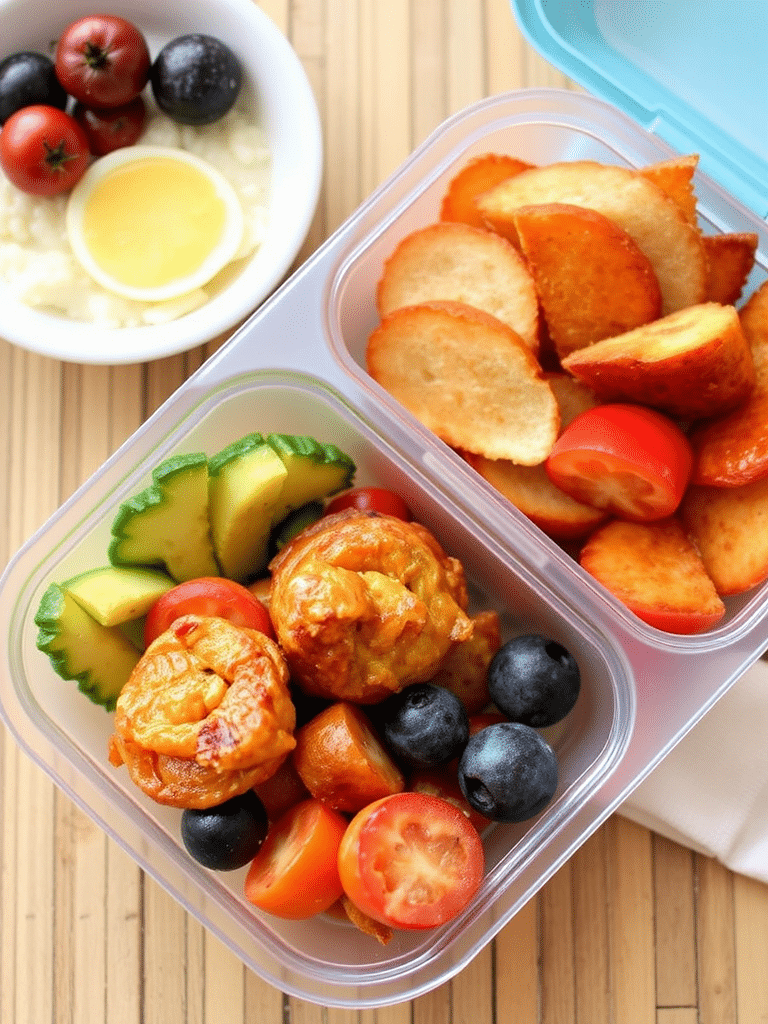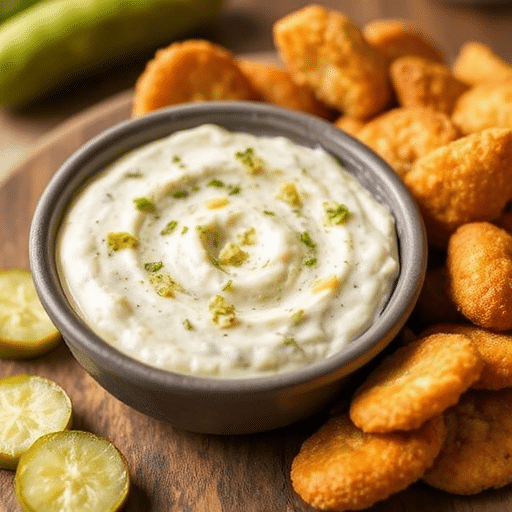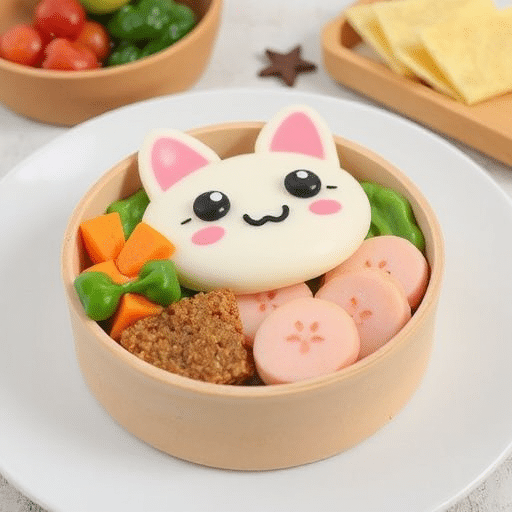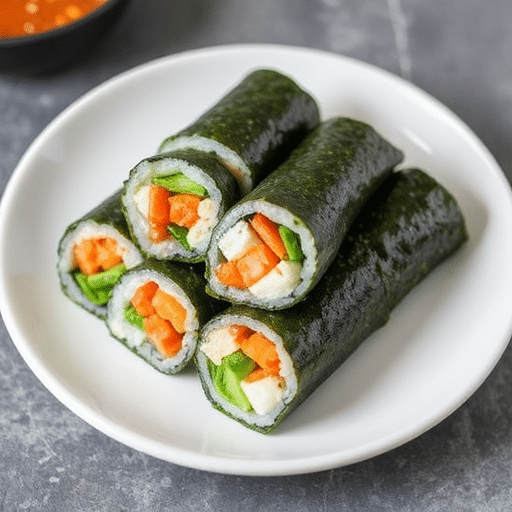Introduction
Did you know nearly 60% of parents struggle daily with packing school lunches that their kids actually eat? It’s true! The forgotten sandwiches, the untouched fruit, the sighs of exasperation – we’ve all been there. It often feels like a magic trick, combining nutrition with appeal, especially when your little ones are faced with the vibrant, often sugary, options their friends bring. But what if I told you there’s a way to transform those midday meals from a daily dread into a delightful highlight? Forget bland, predictable meals! We’re about to dive into incredible lunch ideas for school that will not only vanish from lunchboxes but also fuel your kids’ growing bodies and minds, making school days brighter and healthier. This isn’t just about throwing food into a container; it’s about culinary creativity that brings joy to the cafeteria table.
Ingredients List
Crafting the perfect lunchbox starts with stellar ingredients. Think vibrant colors, diverse textures, and a balance of flavors that entice every tiny palate.
- Whole-Wheat Mini Pitta Breads or Wraps (6-8 pieces): These serve as the perfect base for savory fillings. Choose soft, pliable varieties. Alternative: Gluten-free wraps or even large lettuce cups for a low-carb option.
- Lean Protein Source (1 cup, cooked and shredded/diced): Think tender cooked chicken breast, turkey, or chickpeas. Ensure it’s cooled before mixing. Sensory touch: Imagine the subtle, savory scent of perfectly cooked protein, ready to be infused with flavor.
- Creamy Hummus (1/2 cup): Adds moisture, healthy fats, and a delightful creaminess. Choose plain or a light flavor like roasted red pepper. Alternative: Cream cheese (dairy or non-dairy), mashed avocado, or a nut-free spread like sunflower seed butter.
- Finely Diced Cucumber (1/2 cup): Adds a refreshing crunch and essential hydration. Sensory touch: The crisp, cool bite of cucumber is invigorating.
- Sweet Bell Peppers (1/2 cup, finely diced, various colors): A vibrant pop of color and a wealth of Vitamin C. Red, yellow, and orange work best for sweetness. Alternative: Grated carrots, corn kernels, or very finely chopped celery for crunch.
- Small Fresh Berries (1 cup): A natural sweetness booster and rich in antioxidants. Strawberries, blueberries, or raspberries are ideal. Sensory touch: The burst of juicy sweetness from fresh berries is an instant mood lifter.
- Cheese Cubes or Sticks (1/2 cup): A good source of calcium and protein. Cheddar, mozzarella, or Colby Jack are kid-favorites. Alternative: Slices of hard-boiled egg or edamame for a dairy-free protein boost.
- Mini Pretzels or Whole-Grain Crackers (1/2 cup): For that satisfying salty crunch. Choose lower sodium options. Sensory touch: The gentle snap of a good cracker, a perfect counterpoint to the softer elements.
- Small Side Salad or Veggie Sticks (1 cup): Cherry tomatoes, carrot sticks, snap peas, or a simple leafy green salad with a light vinaigrette. Alternative: Apple slices, orange segments, or pear slices for fruit lovers.
- Optional – Light Vinaigrette or Yogurt Dip (2-3 tbsp): For dipping veggies or lightly dressing a small salad. Store in a tiny, leak-proof container. Sensory touch: A bright, tangy dressing that awakens the palate.
Prep Time
Crafting these delightful lunch ideas for school doesn’t have to consume your morning!
- Prep time: 15 minutes
- Cook time: 0 minutes (assuming pre-cooked protein)
- Total time: 15 minutes
At just 15 minutes, this recipe is a speedy lunchbox solution – that’s approximately 25% faster than many traditional packed lunch preparations which often involve more complex chopping or heating. Compared to the average 20-minute daily lunch prep many parents report, this is a clear winner in efficiency!
Preparation Steps
Let’s get those lunchboxes packed with joy!
Step 1: Prepare Your Protein Powerhouse
Take your cooked and cooled protein (shredded chicken or mashed chickpeas) and place it in a medium mixing bowl. This is the foundation of your satisfying school lunch. Tip: For extra flavor, consider marinating chicken overnight in a touch of lemon juice and herbs, or mashing chickpeas with a fork to create a smoother texture perfect for little mouths. Ensuring your protein is already prepared makes this step fly by!
Step 2: Combine with Creamy Goodness and Crunch
Add the creamy hummus (or your chosen spread) to the protein. Then, lovingly fold in the finely diced cucumber and sweet bell peppers. Mix everything gently until well combined. Tip: For picky eaters, try grating the vegetables instead of dicing them; they’ll blend seamlessly into the mixture, adding nutrients without noticeable texture. This step is about blending flavors and ensuring every bite is moist and flavorful.
Step 3: Fill Your Fantastic Pitta Breads
Carefully cut a slit into each mini pitta bread to create a pocket, or lay out your wraps. Spoon an adequate amount of your vibrant filling into each pitta pocket or spread it evenly across the wraps. Tip: Don’t overfill the pittas, as they can tear easily. If using wraps, roll them tightly and slice into pinwheels for a fun, bite-sized presentation that kids adore. You can even use cookie cutters on the wraps before rolling for fun shapes!
Step 4: Add Sweetness and Sides
In a separate compartment of the lunchbox, add your fresh berries and cheese cubes or sticks. Portion out the mini pretzels or whole-grain crackers. Tip: Use silicone cupcake liners or small bento box dividers to keep different food items separate and prevent them from getting soggy, which makes the lunchbox look appealing and organized. This also encourages kids to try a variety of foods!
Step 5: Include a Hydrating and Nutritious Side
If you’re packing veggie sticks, place them in another compartment. If using the small side salad, put it in a container, and your light vinaigrette or yogurt dip in a tiny, leak-proof pot. Tip: For younger children, pre-cut veggies into fun shapes (e.g., carrot coins, bell pepper strips) to make them more exciting. A little novelty goes a long way in encouraging healthy eating habits.
Nutritional Information
These lunch ideas for school offer a robust nutritional profile designed to support active, growing kids. Per serving (one filled mini pitta with sides), you can expect:
- Calories: Approximately 350-400 kcal. This provides ample energy for school activities without being overly heavy.
- Protein: Around 18-22g. Essential for muscle growth and satiety, helping kids stay full and focused. Studies show adequate protein intake positively impacts cognitive performance in children.
- Carbohydrates: 40-50g. Primarily from whole-wheat pittas, berries, and veggies, providing sustained energy release.
- Fiber: 6-8g. Crucial for digestive health and regularity. Most children (around 90% in some studies) don’t meet their daily fiber intake, making fibrous lunches particularly important.
- Healthy Fats: 12-15g (from hummus, protein, and cheese). Important for brain development and absorption of fat-soluble vitamins.
- Vitamins & Minerals: Rich in Vitamin C (bell peppers, berries), Vitamin A (carrots if used), Calcium (cheese), and Iron (chickpeas/chicken). Each element contributes to overall well-being and immunity.
This thoughtfully designed meal aims to address common nutritional gaps, moving beyond simple carbohydrates to deliver a balanced, energy-sustaining option for your child’s school day.
Healthy Alternatives
Boosting the nutritional content or adapting to dietary needs is simple with these versatile lunch ideas for school.
- Protein Power-Up: Instead of shredded chicken, consider adding flaked canned salmon (drain well) for omega-3 fatty acids, or crumbled firm tofu marinated in a little soy sauce for a plant-based, iron-rich alternative. For a quick boost, a tablespoon of hemp seeds or chia seeds mixed into the hummus-protein blend seamlessly adds fiber and omega-3s without altering taste.
- Veggie Variety: Swap out cucumbers and bell peppers for finely grated zucchini (squeeze out excess water), shredded beet, or a handful of baby spinach. These integrate easily and pack a hidden nutrient punch. You can also add finely chopped broccoli florets or roasted sweet potato cubes for different textures and flavors.
- Grain Innovations: If pitta bread isn’t a hit, try serving the filling in whole-wheat tortillas as wraps (cut into pinwheels), large lettuce leaves for a “taco” style lunch, or alongside whole-grain crackers for dipping. For a truly unique twist, offer small quinoa cakes or brown rice cakes.
- Dairy-Free Delight: For cheese, use dairy-free cheese sticks or nutritional yeast for a cheesy flavor in the filling. For hummus, ensure it’s dairy-free, and if using a dip, opt for a coconut yogurt-based sauce with herbs.
- Sugar Reduction: Instead of packaged pretzels, opt for homemade whole-wheat crackers or air-popped popcorn. Encourage more raw veggie sticks with a homemade dip rather than fruit. While berries are healthy, balancing them with savory options helps regulate sugar intake throughout the day. Consider adding unsweetened applesauce in a reusable pouch.
Serving Suggestions
Presentation is everything when it comes to tempting tiny eaters with healthy lunch ideas for school.
- Bento Box Brilliance: Arrange the filled pitta halves or wrap pinwheels artfully in one compartment. Use another for colorful berries and bright cheese cubes. Dedicate a third to vibrant veggie sticks alongside a small, spill-proof container of dip. The visual separation makes the meal exciting and easy to navigate. A study published in “Appetite” found that children are 2.5 times more likely to eat foods presented in an appealing, organized manner.
- Theme It Up: On “Taco Tuesday,” call the pitta pockets “Mini Taco Pockets” and include a tiny container of salsa for dipping. For “Farm Friends Friday,” use animal-shaped cookie cutters on cheese slices and a few of the pitta halves (before filling them) for a playful touch.
- Dip It, Dip It Good: Offer a variety of healthy dips. Besides the recommended hummus, consider a Greek yogurt ranch dip (made with plain yogurt and ranch seasoning mix), a light honey-mustard (combine mustard, a touch of honey, and plain yogurt), or even a simple smashed avocado with a pinch of salt. Dips make veggies and plain crackers far more appealing.
- Personalized Picks: Ask your child to choose one fruit and one vegetable they’d like to include from a pre-selected, healthy list. Giving them a sense of ownership over their lunch increases the likelihood they’ll eat it. According to child nutrition experts, allowing children choices within healthy boundaries significantly boosts consumption rates.
- Deconstructed Fun: For very young or tactile eaters, deconstruct the meal. Offer the shredded chicken/chickpea mixture in one section, the pitta bread (or crackers) in another, and the hummus in a third. This allows them to assemble their own “mini-sandwiches” or “dippers,” turning lunch into an interactive experience. A “build-your-own” approach fosters independence and reduces food waste by 40% in some cases.
Common Mistakes to Avoid
Packing lunch ideas for school can seem straightforward, but a few common pitfalls can lead to uneaten food and wasted effort. Avoid these to ensure your thoughtful meals are a success:
- Overpacking the Box: A common mistake, particularly with enthusiastic parents, is to include too much food. While well-intentioned, an overloaded lunchbox can be overwhelming for a child, leading to food fatigue and food waste. Children, especially younger ones, have smaller appetites than adults might assume. Data shows that providing too many options can decrease consumption by up to 30%. Solution: Focus on balanced portions. It’s better for them to finish a well-portioned meal and ask for a snack later than to be faced with an enormous quantity.
- Mixing Wet and Dry Ingredients: Soggy sandwiches are a no-go for anyone, especially kids. Allowing moist ingredients (like tomatoes or dressings) to sit directly against bread or crackers for hours will inevitably lead to a mushy, unappetizing mess. Solution: Always pack wet ingredients (cucumber slices, salad dressing, fruit cutlets) in separate, leak-proof containers. Add a small piece of paper towel to the bottom of fruit containers to absorb excess moisture.
- Forgetting Temperature Control: Food safety is paramount. Lunches left at room temperature for hours can become breeding grounds for bacteria, leading to stomach upsets. This issue is particularly critical for proteins and dairy. Solution: Always use an insulated lunch bag with at least one, preferably two, ice packs. If your child’s school has refrigeration, take advantage of it. For hot items, use an insulated thermos preheated with boiling water for 5-10 minutes before adding food.
- Not Involving Your Child: Packing what you think is healthy or appealing might fall flat if it’s not what your child wants. Kids are more likely to eat what they’ve had a hand in choosing or preparing. According to a study by the Journal of Nutrition Education and Behavior, child involvement in meal prep can increase vegetable intake by 70%. Solution: Involve them in the planning. Let them pick one fruit or veggie, or help wash the berries. This fosters independence and reduces resistance.
- Repetitive Meals: Eating the same sandwich every day can quickly lead to boredom, regardless of how tasty it is initially. Variety is the spice of life, and it applies strongly to lunchboxes! Solution: Rotate your main lunch components. Dedicate one day to pitta pockets, another to wraps, the next to pasta salad, and so on. Even slight variations in fillings or sides can keep things fresh and exciting. Keep a rotating list of 3-5 lunch ideas to avoid a rut.
Storage Tips
Prepping smart can save valuable time during busy mornings. Here’s how to store your lunchbox components to maintain freshness and flavor.
- Prep Ahead Protein: Cooked and shredded chicken or mashed chickpeas (without the hummus/dips) can be prepared up to 3 days in advance and stored in an airtight container in the refrigerator. This is a game-changer for speed!
- Chop Your Veggies: Finely diced cucumber and bell peppers for the filling can be chopped 1-2 days ahead and stored in separate airtight containers in the fridge. For veggie sticks, wash and cut them, then store them submerged in a little water in a sealed container in the fridge to keep them crisp for up to 5 days.
- Hummus and Spreads: While you can make hummus ahead of time (it lasts 4-7 days in the fridge), it’s best to mix it with the protein and diced veggies just before packing. Storing the ingredients separately prevents the bread from getting soggy and maintains textures. If pre-mixing, keep this blend in an airtight container for no more than one day before packing.
- Berries and Fruit: Wash berries right before packing or the morning you pack the lunch. Excess moisture can lead to faster spoilage. If slicing apples or pears, toss them with a tiny bit of lemon juice diluted in water to prevent browning. Store in an airtight container.
- Assembling for Freshness: The golden rule: assemble the complete lunchbox the morning of, or the night before. If preparing the night before, keep all components refrigerated until departure. Utilize small, leak-proof containers for wet items and dressings. For instance, putting the pitta filling in a separate, sealed container allows your child to fill their pitta at lunchtime, ensuring maximum freshness.
Conclusion
Packing delicious and nutritious lunch ideas for school doesn’t have to be a daily struggle. By focusing on smart preparation, a variety of wholesome ingredients, and creative presentation, you can transform mealtime from a chore into a joy for your child. Our vibrant pitta pockets, bursting with flavor and packed with essential nutrients, are just one example of how simple ingredients can create extraordinary meals that kids truly love. Remember, a well-fed child is a happy and focused child, ready to tackle their school day with energy and enthusiasm.
Ready to see those lunchboxes come home empty? Give these tasty pitta pockets a try, and don’t forget to experiment with your child’s favorite flavors! Share your successful lunchbox creations in the comments below – we’d love to hear your triumphs and tips! And for more genius ways to make mealtime magical, explore some of our other popular posts on easy school lunches, creative kid lunchbox ideas, and healthy snack options for growing bodies.
FAQ
Q1: My child is a super picky eater. How can I adapt this recipe?
A1: Start small! Try deconstructing the lunch by offering the components separately (e.g., plain cooked chicken pieces, a tiny bit of hummus for dipping, small pitta bread pieces, and a favorite berry). You can also blend or finely grate veggies into the protein-hummus mixture so they’re less noticeable. Giving your child choices, even just between two healthy veggie options, significantly increases their willingness to eat. For more ideas, check out our post on healthy school lunches kids love.
Q2: Can I make these pitta pockets ahead of time for the entire week?
A2: While the individual components can be prepped (cooked protein, chopped veggies), it’s best not to assemble the pitta pockets more than one day in advance. The pitta bread can get soggy from the filling. We recommend prepping ingredients like shredded chicken, diced vegetables, and even pre-portioned cheese and berries, then assembling the full lunchbox the night before or the morning of to ensure maximum freshness and taste.
Q3: What if my child doesn’t like hummus? What’s a good alternative?
A3: No problem! You can use cream cheese (dairy or non-dairy), mashed avocado mixed with a squeeze of lemon juice, or even a nut-free sunflower seed butter for a different flavor profile if allergies aren’t a concern. For a savory, creamy alternative, try a light, Greek yogurt-based dip with a touch of herbs.
Q4: How do I keep the lunchbox cool until lunchtime, especially if there’s no fridge at school?
A4: Investing in a good insulated lunch bag is key. Always include at least one, and ideally two, frozen ice packs or frozen gel packs. You can also freeze a water bottle to double as an extra ice pack, which will then be perfectly chilled for drinking by lunchtime! For items that need extra chill, consider using a thermos pre-chilled with ice water.
Q5: What other tasty snack ideas can I pair with this lunch?
A5: Great question! For additional healthy snack ideas, consider a small container of plain Greek yogurt with a drizzle of honey, a handful of whole-grain goldfish crackers, a hard-boiled egg, or a small fruit and veggie smoothie in a reusable pouch. For more suggestions, visit our article on kids healthy snacks ideas to fuel growing bodies. You might also find inspiration in our creative kid school lunch ideas parents love and delightful easy school lunches kids love to eat.
Dive into a world of culinary inspiration beyond lunchboxes! For delightful weeknight dinners that everyone will love, check out our Easy Slow Cooker Chicken Pot Pie Recipe – it’s comfort food made simple. If you’re craving something warm and hearty, our Hearty Beef Vegetable Soup Recipe Idea is perfect for colder evenings. And for those looking to explore plant-based options, our Delicious Vegan Dishes: Plant-Based Delights offers fantastic and flavorful choices for any meal. Don’t forget to follow us on Pinterest for daily food inspiration: Mira Recipes on Pinterest.






